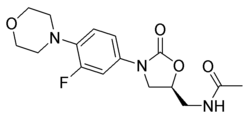In response to the emergence of resistant bacteria, efforts are being made to develop antimicrobial agents that are active against these resistant organisms. The oxazolidinones are a new family of totally synthetic antimicrobials for which there are no preexisting resistance genes in bacteria. Moellering reviewed the activity and clinical use of linezolid, the first oxazolidinone approved for use in the United States.
Linezolid exerts its antimicrobial effect by a unique mechanism of action that results in inhibition of bacterial ribosome assembly. Because no other known antimicrobial agent inhibits this process, there is no cross-resistance with other antibiotics. All major pathogenic gram-positive bacteria are sensitive to linezolid in vitro. The drug demonstrates in vitro activity against major strains of Neisseria and borderline activity against Haemophilus influenzae, but it is inactive against Enterobacteriaceae and Pseudomonas species. Although linezolid has demonstrated activity against atypical organisms, including Legionella pneumophila, Mycoplasma pneumoniae, and Chlamydia pneumoniae, more data are needed on its effectiveness against these organisms in vivo. The response to combinations of linezolid with other antibiotics appears to be additive or neutral, and rarely antagonistic or synergistic. Development of resistance is rare but has occurred in patients with indwelling prostheses who received long-term linezolid therapy.
Recommended dosing is 400 to 600 mg twice daily, administered orally or intravenously. No dosing adjustment is needed for weight, gender, or time of administration in relation to meals. Linezolid is metabolized by oxidation, and its pharmacokinetic characteristics are not affected by renal or hepatic dysfunction. Drug accumulation has been noted in patients with impaired renal function, but clinical significance has not been determined. Serum drug concentrations are decreased after hemodialysis; available data suggest that postdialysis supplemental dosing is necessary.
Linezolid is currently approved by the U.S. Food and Drug Administration for use in treating, among others, the following infections: vancomycin-resistant Enterococcus faecium infections, community-acquired or nosocomial pneumonia caused by penicillin-susceptible Streptococcus pneumoniae or Staphylococcus aureus, and skin infections caused by S. aureus or Streptococcus pyogenes. Because of lack of activity against H. influenzae, linezolid should not be considered a first-line drug for community-acquired pneumonia. Studies are being conducted to evaluate the effectiveness of linezolid in patients with endocarditis, osteomyelitis, and meningitis.
Adverse effects of linezolid are rare, but reversible myelosuppression, notably thrombocytopenia, has been noted. Weekly complete blood counts are recommended during therapy, especially in patients receiving linezolid for more than two weeks.
The author concludes that linezolid is useful against almost all of the important gram-positive organisms. It is effective in skin, respiratory, and systemic infections caused by susceptible organisms, but it should not be considered a first- or second-line therapy for community-acquired respiratory infections. Compared with vancomycin, linezolid may result in shorter hospital stays for patients with known or suspected methicillin-resistant staphylococcal infections. However, the cost per dose for linezolid is relatively high: approximately $53 for one 600-mg oral dose and $72 for a 600-mg intravenous dosing vial. No clinical trials have compared the efficacy of linezolid to that of quinupristin-dalfopristin (another intravenously administered antimicrobial that is used to treat multiresistant gram-positive infections).
Moellering RC Jr. Linezolid: the first oxazolidinone antimicrobial. Ann Intern Med January 21, 2003;138:135-42.
COPYRIGHT 2003 American Academy of Family Physicians
COPYRIGHT 2003 Gale Group



